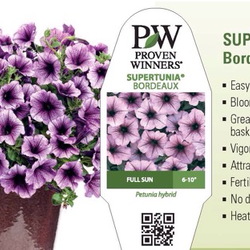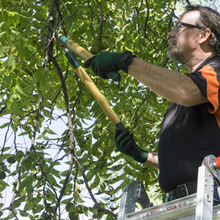I've never known a gardener who is blasé about black. That color in a flower has always intrigued some gardeners and repulsed others. When 'Black Velvet' bursts onto the garden scene in 2011, there are bound to be both accolades and brickbats. For the time being, the accolades have it by a long shot.

Potted 'Black Velvet' in a garden setting 
Petunia 'Phantom' 
Petunia 'Pinstripe'
On July 12, 2010, 'Black Velvet' was the star of the Greenhouse Grower's Association Evening of Excellence. It earned not one but two awards that evening: Industry's Choice and Reader's Choice. Even earlier, at the California Spring Trials in April, it was the talk of the show. The selling point and slogan accompanying this petunia, it appears, will be "Black goes with everything!"
There are those who caution that 'Black Velvet's' flower power may strike gardeners as underwhelming. We've gotten used to floriferous varieties like the Wave series, the Supertunias, and the Cascadias. Some critics say that although the photos tend to show plants with lots of blossoms, they may not flower particularly well, once planted in the average garden. That claim is based on observations at two trial gardens, one in the city of Buffalo, New York, and one at Penn State's Lancaster County research farm.
Almost lost in all the hype are two of 'Black Velvet's' sister varieties, rolled out by Ball FloraPlant at the same time: 'Phantom' and 'Pinstripe.' 'Phantom' has a large yellow star on a "black" background. Except for narrower stripes, 'Pinstripe' closely resembles 'Phantom.' Although almost all the attention is focused on 'Black Velvet,' of the three new varieties, 'Phantom,' with its beautiful star image and stunning color contrast, is by far my favorite of the three.
But is it really black?
As with other "black" flowers, someone is bound to point out that the color is not truly black. Let me be among the first, regarding these petunias. If you look closely at the photo insets at left, you'll see just a hint of very dark burgundy/purple in the upper right corner in the 'Black Velvet' inset. It's somewhat more noticeable at the edges of the star in 'Phantom, and most noticeable on 'Pinstripe,' where the "black" background bleeds into the stripes profusely.
Although there has been lots of interest in "black" flowers in recent years, with plant breeders exerting great effort to create "black" ones, such blooms were even more popular in Victorian and Edwardian times. Taken together, the "black" flowers of times gone by (but still available today) plus those created in more modern times number over 2,750!So, do "black" flowers really go with "everything?"
Not as far as I'm concerned. The combining of colors in the garden is a very subjective, individual matter. I don't care for "black" and red, for instance, while others might think they look fantastic together. Among my favorite colors to pair with "black" are white, gold, pink, and lavender. If you're a fan of "black" flowers, why not snag a couple of 'Black Velvet' petunias next spring and see how they pair up with what else is growing in your garden?!Growing Your "Black" Petunias Plant in Sun (at least 6 hrs. of sun) Credits |  Petunia 'Black Velvet' with Euphorbia 'Breathless' |
Please scroll down to leave a comment.
© Larry Rettig 2010






















